有机电致发光器件OLED的结构和发光机理
OLED器件结构与发光机理
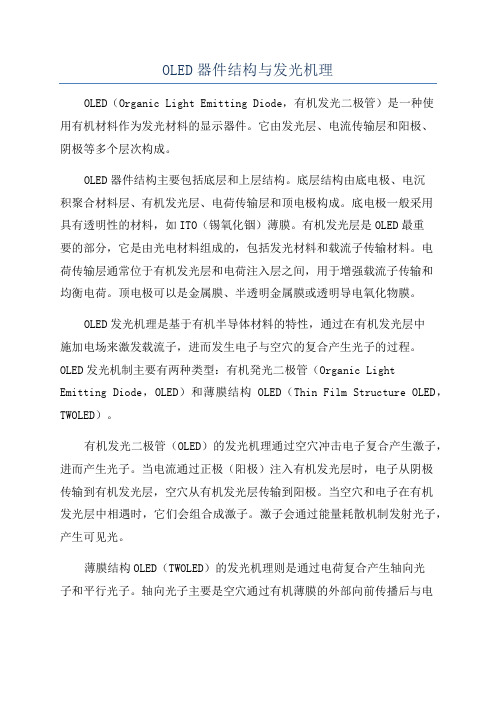
OLED器件结构与发光机理OLED(Organic Light Emitting Diode,有机发光二极管)是一种使用有机材料作为发光材料的显示器件。
它由发光层、电流传输层和阳极、阴极等多个层次构成。
OLED器件结构主要包括底层和上层结构。
底层结构由底电极、电沉积聚合材料层、有机发光层、电荷传输层和顶电极构成。
底电极一般采用具有透明性的材料,如ITO(锡氧化铟)薄膜。
有机发光层是OLED最重要的部分,它是由光电材料组成的,包括发光材料和载流子传输材料。
电荷传输层通常位于有机发光层和电荷注入层之间,用于增强载流子传输和均衡电荷。
顶电极可以是金属膜、半透明金属膜或透明导电氧化物膜。
OLED发光机理是基于有机半导体材料的特性,通过在有机发光层中施加电场来激发载流子,进而发生电子与空穴的复合产生光子的过程。
OLED发光机制主要有两种类型:有机発光二极管(Organic Light Emitting Diode,OLED)和薄膜结构OLED(Thin Film Structure OLED,TWOLED)。
有机发光二极管(OLED)的发光机理通过空穴冲击电子复合产生激子,进而产生光子。
当电流通过正极(阳极)注入有机发光层时,电子从阴极传输到有机发光层,空穴从有机发光层传输到阳极。
当空穴和电子在有机发光层中相遇时,它们会组合成激子。
激子会通过能量耗散机制发射光子,产生可见光。
薄膜结构OLED(TWOLED)的发光机理则是通过电荷复合产生轴向光子和平行光子。
轴向光子主要是空穴通过有机薄膜的外部向前传播后与电子相遇产生复合,产生的光子从薄膜的垂直方向发出。
平行光子主要是空穴与电子的正方向进行复合,产生的光子从薄膜的平行方向发出。
两种发光机理都是通过电子与空穴的复合产生光子来实现OLED的发光。
OLED器件结构和发光机理的优势在于材料可塑性高、分辨率高、对比度高、透明度高、颜色饱和度高等特点。
因此,OLED被广泛应用于各种显示设备中,如手机、电视、显示屏、车载显示等领域。
有机电致发光器件OLED技术介绍

有机电致发光器件OLED技术介绍有机电致发光器件OLED(Organic Light Emitting Diode)是一种新型的发光器件技术,由有机材料制成。
OLED技术结合了有机材料的特性和发光器件的的特性,可以在不需要背光的情况下发出颜色丰富、亮度较高的光。
它具有响应快、发光效率高、能耗低等优点,因此在显示技术领域具有广阔的应用前景。
OLED技术是基于有机材料中的发光现象。
有机材料是一种由碳元素构成的化合物,具有很强的光致发光特性。
与传统的LED器件相比,OLED器件不需要外部的背光源,而是利用有机材料自身的特性直接发光,因此OLED器件可以制作得非常薄,达到几个纳米的厚度。
OLED器件由四个不同的部分组成:一层有机发光层、两层电极和一层衬底层。
其中,有机发光层是OLED器件的最关键部分,它薄至仅几纳米,通过在该层中注入电荷,有机分子发生电致发光现象。
电荷分为正电荷和负电荷,它们在有机发光层内重组,释放出能量并发出光。
有机发光层的材料通常采用芳香族化合物以及有机金属配合物等。
OLED的工作原理是由电流经过电极进入有机发光层时,电流携带着电子和正孔进入有机发光层,电子和正孔在该层中相遇并发生复合。
在复合的过程中,电荷之间的能量被释放成光能,发出可见光。
而且,由于电荷可以自由运动,OLED器件具有快速的响应速度,可以实现高频率的图像刷新,扩大了其在电视和显示器领域的应用。
OLED技术具有许多优势。
首先,它可以制造出非常薄、灵活的器件。
由于有机材料可以制造成非常薄的膜,因此OLED显示器可以做到薄如蝉翼,并且可以弯曲、折叠,实现更灵活的设计。
其次,OLED器件具有高亮度和鲜艳的颜色。
由于OLED器件可以直接发光,而不需要背光源,因此可以实现更高的亮度,并且颜色更加鲜艳,对比度更高。
此外,OLED 器件的发光效率也比传统的LED器件高,能耗更低。
最后,OLED器件具有非常快速的响应速度。
由于电荷在有机材料中的运动速度非常快,因此OLED器件可以实现高频率的图像刷新,不会出现拖影现象。
oled 显示原理

oled 显示原理
OLED(Organic Light-Emitting Diode)是一种采用有机材料制
成的发光二极管。
它的显示原理是基于电致发光效应,通过外加电压,使有机材料发光并产生光电子的过程。
OLED显示原理与传统液晶显示器不同,不需要背光源,因此OLED可实现自发光,具有高对比度和快速响应的特点。
OLED的基本结构包括两个电极——阳极和阴极,以及位于两
电极之间的有机材料层。
有机材料层由多个薄层构成,包括发光层、电子传输层和空穴传输层等。
这些材料在不同层之间形成能级梯度,通过控制层之间的电流和电压,可以在有机材料中产生电子和空穴。
当电流通过阳极和阴极时,电子从电子传输层注入到发光层,空穴从空穴传输层注入到发光层,电子与空穴在发光层相遇并复合,发生电子的激元复合过程。
在发光层产生的激元复合过程中,电子和空穴会释放出能量,激发有机材料自身的共振跃迁,从而产生发光。
不同有机材料的能带结构和化学组成会决定发光颜色的差异。
OLED的发光原理紧密相关,通过控制材料的选择和结构优化,可以实现多彩的发光效果。
此外,OLED还可以被制成柔性显
示器,因为有机材料层可以非常薄和柔韧。
总之,OLED通过电致发光效应,利用有机材料的特性实现了
自发光的显示效果。
其高对比度、快速响应和柔性特点,为电子显示领域带来了新的突破。
有机电致发光器件OLED技术介绍

有机电致发光器件OLED技术介绍有机电致发光器件(Organic Light-Emitting Diode, OLED)是一种新型的发光器件技术,由有机材料构成。
与传统的液晶显示技术相比,OLED具有更高的亮度、对比度、响应速度和视角范围。
它也具有更薄、更轻、更柔性以及更低的功耗特性。
因此,OLED被广泛运用于电视、手机、平板电脑和显示屏等各种领域。
以下是OLED技术的介绍。
首先,OLED的工作原理是通过在有机材料中注入电流来激发有机分子发光。
它由四个主要的组成部分构成:有机发光层、电子传输层、空穴传输层和电子注入层。
当电流通过电子传输层和空穴传输层时,电荷载流子在发光层中结合并释放出能量,产生光子。
这一发射光子的过程是受电流调控的,因此可以随时调整亮度。
OLED的一个重要特点是可以实现主动矩阵驱动,这意味着每个像素点都能够独立控制。
这种能力使得OLED在显示领域非常有优势。
与传统的液晶显示技术相比,液晶显示技术需要背光源才能产生光亮的像素。
而OLED每个像素都能够自己发光,因此具有更高的对比度和更广的视角范围。
此外,OLED还具有高亮度和真实色彩的优势。
有机材料可以发射出非常鲜艳和纯净的颜色,而且亮度更高,使得OLED在显示领域表现出色。
在电视和手机等大屏幕设备上,OLED可以提供更丰富、逼真的视觉体验。
另外,OLED的柔性特性也为其应用提供了更多可能。
传统的液晶显示器需要通过切割和粘贴的方式来制作大屏幕设备,而OLED可以在柔性底板上制作,从而实现超薄和弯曲的显示器。
这使得OLED可以应用于可穿戴设备、卷曲屏幕和可折叠设备等领域。
尽管OLED在显示技术中有着许多优势,但也存在一些挑战。
其中之一是有机材料的寿命问题。
有机材料在使用过程中会逐渐降解和失去发光性能,从而影响显示质量和寿命。
为了解决这个问题,研究人员一直在努力开发新的有机材料以提高稳定性。
另一个挑战是制造成本。
目前,OLED 的制造成本相对较高,限制了其在大规模应用中的普及。
oled发光原理
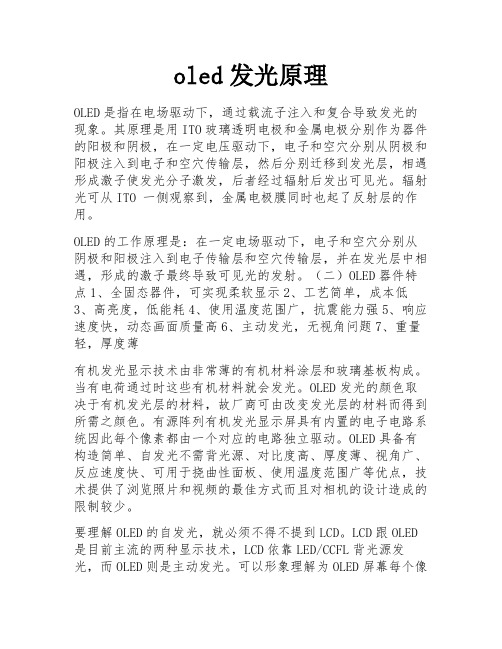
oled发光原理OLED是指在电场驱动下,通过载流子注入和复合导致发光的现象。
其原理是用ITO玻璃透明电极和金属电极分别作为器件的阳极和阴极,在一定电压驱动下,电子和空穴分别从阴极和阳极注入到电子和空穴传输层,然后分别迁移到发光层,相遇形成激子使发光分子激发,后者经过辐射后发出可见光。
辐射光可从ITO 一侧观察到,金属电极膜同时也起了反射层的作用。
OLED的工作原理是:在一定电场驱动下,电子和空穴分别从阴极和阳极注入到电子传输层和空穴传输层,并在发光层中相遇,形成的激子最终导致可见光的发射。
(二)OLED器件特点1、全固态器件,可实现柔软显示2、工艺简单,成本低3、高亮度,低能耗4、使用温度范围广,抗震能力强5、响应速度快,动态画面质量高6、主动发光,无视角问题7、重量轻,厚度薄有机发光显示技术由非常薄的有机材料涂层和玻璃基板构成。
当有电荷通过时这些有机材料就会发光。
OLED发光的颜色取决于有机发光层的材料,故厂商可由改变发光层的材料而得到所需之颜色。
有源阵列有机发光显示屏具有内置的电子电路系统因此每个像素都由一个对应的电路独立驱动。
OLED具备有构造简单、自发光不需背光源、对比度高、厚度薄、视角广、反应速度快、可用于挠曲性面板、使用温度范围广等优点,技术提供了浏览照片和视频的最佳方式而且对相机的设计造成的限制较少。
要理解OLED的自发光,就必须不得不提到LCD。
LCD跟OLED 是目前主流的两种显示技术,LCD依靠LED/CCFL背光源发光,而OLED则是主动发光。
可以形象理解为OLED屏幕每个像素点都是一个小灯泡,而LCD则是百叶窗后面放几个大灯泡。
LCD可以在几百上千个分区内进行控光,而OLED相当于拥有几百万、甚至上千万的像素级灯管,控光能力当然不是一个数量级。
OLED是指有机发光二极管,或称为有机电致发光器件。
原理很简单,人们很早就发现将某种有机材料(小分子的或者聚合物的)夹在正负电极之间,当施加电压并有电流流过时,该有机材料就会发光,当选择不同的有机材料,就会获得不同的发光色,从而可以制作彩色显示屏。
有机发光二极管的原理是

有机发光二极管的原理是
有机发光二极管(OLED)的工作原理可以简要总结为以下几个步骤:
1. 加入电压
向OLED器件施加外部电压,其阳极和阴极之间形成一个电场。
2. 电子发光层注入载流子
在电场作用下,阴极会注入电子,阳极会注入电洞到发光层。
发光层材料具有电子传输性,可以传递载流子。
3. 电子孔在发光层复合
发光层内部,电子和电洞相遇并复合,这会使电子从高能级跃迁到低能级,并释放出能量差所对应的光子,此过程称为电致发光。
4. 光子穿透阳极
发光层释放出的光子会向各个方向传播,其中一部分会抵达阳极。
如果阳极使用透明材料制成,光子可以穿透阳极射出。
5. 形成图像
OLED像素以矩阵排布,通过控制每个像素点的电压及发光强度,可以形成所需要的图像、视频等视觉信息。
6. 色彩调变
通过改变发光层的材料制成,可以emit不同颜色的光,如红绿蓝三原色光,组合可形成各种颜色。
7. 提高发光效率
加入载流子传输层、电子阻隔层等结构,可以提高注入效率,增强载流子复合几率,从而提高发光量子效率。
8. 延长使用寿命
选择稳定的材料,优化各层的厚度,封装技术等,可以大幅延长OLED的使用寿命。
综上所述,OLED的发光原理利用了有机半导体材料的电致发光性能,通过电子迁跃发光形成图像,是一种全固态的自发光显示技术,具有发光效率高、响应速度快
等优点。
有机电致发光器件(OLED)课件
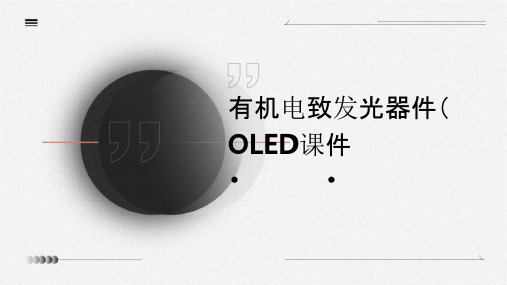
OLED技术的创新与突破
提高效率和稳定性
通过材料和工艺的改进,提高OLED的发光效率和 稳定性,延长使用寿命。
柔性显示技术
进一步研究柔性OLED显示技术,实现更轻薄、可 弯曲的显示产品。
多功能集成
探索将触摸功能、传感器等集成到OLED显示面板 中,实现更多功能。
OLED产业的发展趋势与展望
市场规模持续增长
随着OLED在更多领域的应用,市场规模将持续增长,带动产业的 发展。
技术竞争加剧
随着技术的不断进步,OLED产业将面临激烈的技术竞争,促使企 业加大研发投入。
产业布局优化
随着全球产业格局的变化,OLED产业将进一步优化布局,形成更 加合理的产业链结构。
感谢观看
有机电致发光器件( OLED课件
• OLED基础知识 • OLED器件结构与性能 • OLED制造工艺与设备 • OLED市场与技术发展趋势 • OLED的未来展望
01
OLED基础知识
OLED的定义与特点
总结词
OLED是一种有机电致发光器件,具有自发光的特性,能够实现高对比度、广 视角、快速响应等优点。
OLED在未来的应用前景
显示器技术
随着显示技术的不断进步,OLED 有望成为下一代主流显示技术, 广泛应用于电视、电脑、手机、 平板等电子产品。
照明领域
OLED具有自发光的特性,可以做 成柔性的照明产品,为室内外照明 提供新的解决方案。
可穿戴设备
随着可穿戴设备的普及,OLED的轻 薄、柔性特点使其在智能手表、健 康监测器等设备上具有广阔的应用 前景。
OLED技术的挑战与机遇
挑战
OLED技术的成本较高,良品率较低,且寿命相对较短,这些 问题制约了OLED技术的进一步普及和应用。
OLED器件结构与发光机理解析

OLED器件结构与发光机理解析OLED(Organic Light Emitting Diode)是有机发光二极管,其结构和发光机理有很大的关系。
下面从结构和发光机理两个方面来解析OLED器件。
一、OLED器件结构1.底部导电玻璃基板:底部导电玻璃基板是OLED器件的基础,主要起到支撑和导电的作用。
通过将ITO(铟锡氧化物)等透明导电材料沉积在玻璃基板上,实现电流的导电,同时还可以透过基板传递光线。
2.有机发光材料层:有机发光材料层是OLED器件发光的核心部分,也被称为发光层。
有机发光材料通常由有机发光分子和离子或溶剂等组成。
有机发光分子通常是含有共轭结构的芳香化合物,如多苯环芳香烃、吡啶类化合物等。
有机发光分子在外加电场作用下,通过激发态和基态之间的跃迁,发射可见光。
3.电子传输层:电子传输层主要是用来提供电子注入和传输的层。
此层通常采用有机材料,如芳香胺、芳香醚等。
电子通过电子传输层进入发光层,与有机发光分子发生能级相互作用,从而实现能级的电荷复合,激活发光分子的发光。
4.阴极:阴极是OLED器件中的辅助电极,起到对OLED器件进行电流注入和电子回收的作用。
阴极通常采用金属材料,如铝、钙等。
当外加正向电压时,阴极注入电子进入电子传输层,与有机发光分子发生复合,从而激发发光。
二、OLED器件发光机理1.激发态跃迁:当外加正向电压时,电子从阴极注入电子传输层,然后传输到发光层。
在发光层中,电子与有机发光分子之间发生能级相互作用,使得发光分子的电子从基态跃迁到激发态。
在激发态下,电子处于高能量状态,此时会吸收光子,使得发光分子发出发光。
发光的波长和颜色取决于有机发光分子的能级结构。
2.基态复合:当电子从激发态返回基态时,激发态电子和基态离子形成复合态,释放出光子能量。
这是OLED器件发光的另一个重要机制。
基态复合的过程会产生较高的量子效率,从而提高OLED器件的发光效率。
总结起来,OLED器件的发光机理是由电子注入到发光层,激发发光分子进入激发态,经过能级跃迁后发出光子,最后发生基态复合产生发光。
OLED有机电致发光材料与器件

OLED有机电致发光材料与器件摘要本文概述了OLED的发展简史,并简单介绍了OLED有机电致发光器件的基本结构与发光机理。
此外,还对比了OLED与PLED,这两种系列材料只是材料特性和成膜方法不同,本质上却无异。
相较于LCD,OLED具有很大优势,但仍面临寿命短等技术瓶颈。
随着研发力度的加大,其技术瓶颈将会被逐渐解决,可以预见在未来的显示市场,OLED必将是绝对主流产品。
关键词:有机电致发光器件;OLED显示器OLED (Organic Light Emitting Device)全名叫做有机电致发光器件,是指有机半导体材料和发光材料在电场驱动下,通过载流子注入和复合导致发光的现象。
其原理是用ITO透明电极和金属电极分别作为器件的阳极和阴极,在一定电压驱动下,电子和空穴分别从阴极和阳极注入到电子和空穴传输层,电子和空穴分别经过电子和空穴传输层迁移到发光层,并在发光层中相遇,形成激子并使发光分子激发,后者经过辐射弛豫而发出可见光。
辐射光可从ITO一侧观察到,金属电极膜同时也起了反射层的作用。
根据这种发光原理而制成显示器被称为有机发光显示器,也叫OLED显示器[1]。
1.OLED有机电致发光显示器件的发展简史1963年New York University的Pope[2]等第一次发现有机材料单晶蒽的电致发光现象。
1982年Vincett[3]的研究小组制备出厚度0.6 蒽的薄膜,并观测到电致发光。
1987年Kodak公司的邓青云等采用了夹层式的多层器件结构,开创了有机电致发光的新的时代[4]。
1990年,英国剑桥大学Cavendish实验室的Burroghes[5]等人首次采用共轭聚合物聚对苯撑乙烯(PPV,polyphenylene vinylene)制作了高分子发光二极管,简化了制备工艺,开辟了发光器件的又一个新领域—聚合物薄膜电致发光器件。
1997年,Princeton Univ. Forrest S R的小组发现磷光的有机电致发光材料,使得有机电致发光器件的内量子效率可能到达100%。
OLED的基本原理
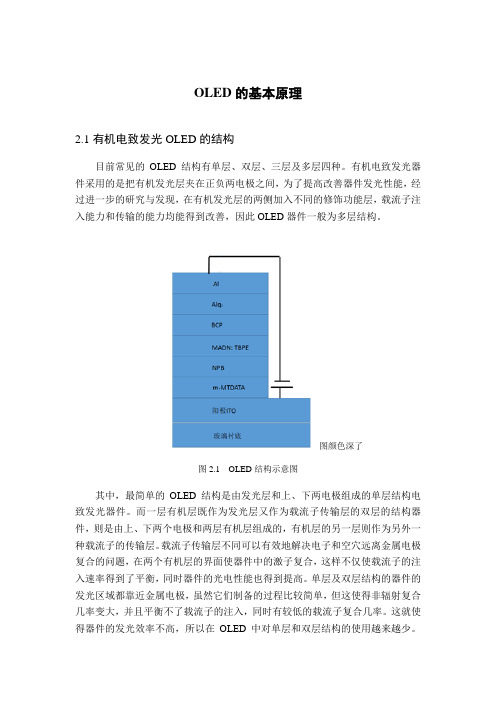
OLED的基本原理2.1有机电致发光OLED的结构目前常见的OLED结构有单层、双层、三层及多层四种。
有机电致发光器件采用的是把有机发光层夹在正负两电极之间,为了提高改善器件发光性能,经过进一步的研究与发现,在有机发光层的两侧加入不同的修饰功能层,载流子注入能力和传输的能力均能得到改善,因此OLED器件一般为多层结构。
图颜色深了图2.1 OLED结构示意图其中,最简单的OLED结构是由发光层和上、下两电极组成的单层结构电致发光器件。
而一层有机层既作为发光层又作为载流子传输层的双层的结构器件,则是由上、下两个电极和两层有机层组成的,有机层的另一层则作为另外一种载流子的传输层。
载流子传输层不同可以有效地解决电子和空穴远离金属电极复合的问题,在两个有机层的界面使器件中的激子复合,这样不仅使载流子的注入速率得到了平衡,同时器件的光电性能也得到提高。
单层及双层结构的器件的发光区域都靠近金属电极,虽然它们制备的过程比较简单,但这使得非辐射复合几率变大,并且平衡不了载流子的注入,同时有较低的载流子复合几率。
这就使得器件的发光效率不高,所以在OLED中对单层和双层结构的使用越来越少。
现在在有机电致发光器件中,用的比较多的器件结构是三层结构,而最多的则是多层结构的使用。
2.2 有机电致发光器件(OLED)的发光原理有机电致发光器件中采用的各种有机材料均为共轭有机分子,依据休克尔分子轨道理论(HMO),并结合半导体理论中的能带理论,可将有机共轭分子中的最高分子占据轨道HOMO类比为能带理论中的价带顶,最低空轨道LUMO类比为导带底,这样就可采用半导体能带理论对有机电致发光进行探讨。
又由于OLED中各功能层材料不同,因此阴极金属/有机层和有机层/ITO界面都可被视为异质结,以半导体理论中的异质结理论来研究OLED的电流传输和复合,并用相关理论来模拟OLED的工作机2理。
OLED的发光原理与无机LED的发光机理相似,属注入型发光器件。
OLED器件结构与发光机理

OLED器件结构与发光机理OLED(Organic Light Emitting Diode)是一种有机发光二极管,通过有机分子的电致发光来实现显示和照明。
OLED器件结构与发光机理包括以下几个方面:一、OLED器件结构:OLED器件由一系列薄膜层构成,主要包括玻璃基板、透明导电层、有机发光层、电子传输层和金属电极层等。
其中,玻璃基板起到支撑作用,透明导电层用于提供电源,金属电极层则用于引出电荷。
而有机发光层是OLED的核心,由发光分子和载流子传输体组成,其结构决定了器件发光的特性。
二、发光机理:OLED的发光机理基于有机分子的电致发光原理。
有机分子具有共轭的pi电子结构,其分子轨道的特性决定了电子和空穴的自旋轨道性质。
OLED的基本工作原理是通过施加外加电场,将电子注入有机发光层,与空穴相遇并发生复合,从而形成激子(exciton)。
激子会发生自旋翻转,并通过辐射或非辐射传递能量,最终发出光。
在OLED发光过程中,激子的复合方式决定了发光机理的不同。
分为荧光和磷光两种情况:1.荧光机理:荧光OLED采用双极分子作为有机发光材料,当电子和空穴相遇时,激子会很快发生复合,并释放出光子。
这种激子的自旋翻转是通过分子內多体作用完成的,可以快速形成发光。
2.磷光机理:磷光OLED采用三极分子作为有机发光材料,激子的自旋翻转需要通过外界的助剂以及激子与助剂之间的相互作用来实现。
这种激子的自旋翻转速度相对较慢,因此在发光之前会有一个相对较长的延迟时间,这使得磷光OLED的发光效率相对较低。
综上所述,OLED器件结构与发光机理中,器件结构决定了发光层的性能和器件的工作特性,而发光机理则是通过激子复合过程完成发光。
不同的发光机理使得OLED器件可以有不同的发光效果,如荧光和磷光。
随着有机材料和器件技术的不断发展,OLED显示技术在手机、电视等领域得到广泛应用,并且在低功耗、高对比度等方面具有独特的优势。
oled屏幕发光原理
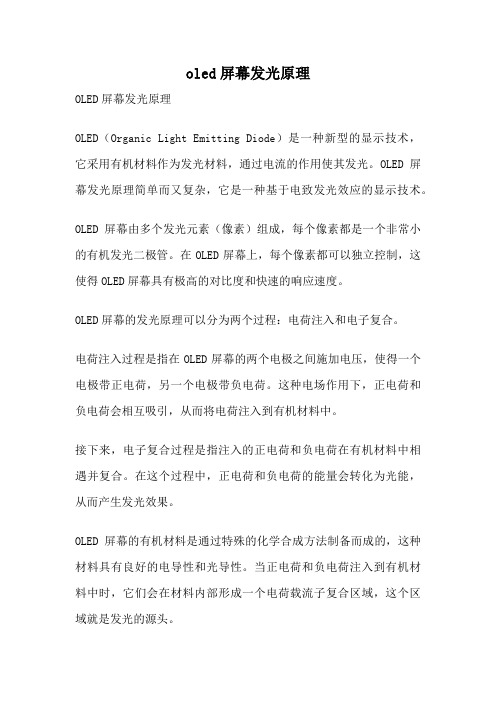
oled屏幕发光原理OLED屏幕发光原理OLED(Organic Light Emitting Diode)是一种新型的显示技术,它采用有机材料作为发光材料,通过电流的作用使其发光。
OLED屏幕发光原理简单而又复杂,它是一种基于电致发光效应的显示技术。
OLED屏幕由多个发光元素(像素)组成,每个像素都是一个非常小的有机发光二极管。
在OLED屏幕上,每个像素都可以独立控制,这使得OLED屏幕具有极高的对比度和快速的响应速度。
OLED屏幕的发光原理可以分为两个过程:电荷注入和电子复合。
电荷注入过程是指在OLED屏幕的两个电极之间施加电压,使得一个电极带正电荷,另一个电极带负电荷。
这种电场作用下,正电荷和负电荷会相互吸引,从而将电荷注入到有机材料中。
接下来,电子复合过程是指注入的正电荷和负电荷在有机材料中相遇并复合。
在这个过程中,正电荷和负电荷的能量会转化为光能,从而产生发光效果。
OLED屏幕的有机材料是通过特殊的化学合成方法制备而成的,这种材料具有良好的电导性和光导性。
当正电荷和负电荷注入到有机材料中时,它们会在材料内部形成一个电荷载流子复合区域,这个区域就是发光的源头。
在OLED屏幕中,每个像素都有三个基本发光颜色:红色(R),绿色(G)和蓝色(B)。
通过调节每个像素的电压,可以控制不同颜色的发光强度,从而实现彩色显示。
OLED屏幕发光原理的优势在于它具有自发光的特点,不需要背光源,使得OLED屏幕更加薄、轻和柔韧。
与传统LCD屏幕相比,OLED屏幕具有更高的对比度、更广的视角和更快的响应速度,同时也能够节省能量。
然而,OLED屏幕也存在一些缺点。
由于有机材料的特殊性质,OLED 屏幕的寿命较短,容易发生颜色偏移和亮度衰减。
此外,由于制造工艺的限制,OLED屏幕的制造成本较高,导致其价格相对较高。
OLED屏幕发光原理是一种基于电致发光效应的显示技术。
通过电荷注入和电子复合的过程,OLED屏幕能够实现自发光,并具有优异的显示效果。
有机电致发光器件(OLED) 的结构和发光机理
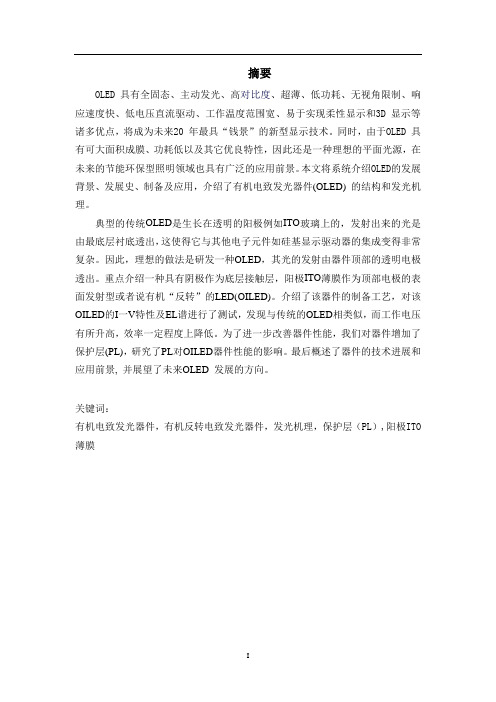
摘要OLED 具有全固态、主动发光、高对比度、超薄、低功耗、无视角限制、响应速度快、低电压直流驱动、工作温度范围宽、易于实现柔性显示和3D 显示等诸多优点,将成为未来20 年最具“钱景”的新型显示技术。
同时,由于OLED 具有可大面积成膜、功耗低以及其它优良特性,因此还是一种理想的平面光源,在未来的节能环保型照明领域也具有广泛的应用前景。
本文将系统介绍OLED的发展背景、发展史、制备及应用,介绍了有机电致发光器件(OLED) 的结构和发光机理。
典型的传统OLED是生长在透明的阳极例如ITO玻璃上的,发射出来的光是由最底层衬底透出,这使得它与其他电子元件如硅基显示驱动器的集成变得非常复杂。
因此,理想的做法是研发一种OLED,其光的发射由器件顶部的透明电极透出。
重点介绍一种具有阴极作为底层接触层,阳极ITO薄膜作为顶部电极的表面发射型或者说有机“反转”的LED(OILED)。
介绍了该器件的制备工艺,对该OILED的I一V特性及EL谱进行了测试,发现与传统的OLED相类似,而工作电压有所升高,效率一定程度上降低。
为了进一步改善器件性能,我们对器件增加了保护层(PL),研究了PL对OILED器件性能的影响。
最后概述了器件的技术进展和应用前景, 并展望了未来OLED 发展的方向。
关键词:有机电致发光器件,有机反转电致发光器件,发光机理,保护层(PL),阳极ITO 薄膜AbstractOLED has a solid state, self-luminous, high contrast, ultra-thin, low power consumption, viewing angle, fast response, low-voltage DC drive, the operating temperature range, easy to implement many of the advantages of flexible displays and 3D displays future20 years of the most "money scene" of the newdisplay because OLED has a large-area film, low power consumption, and other fine features, so an ideal plane light source, also has broad application prospects in the future of energy saving lighting in the area. In this paper, the systematic introduction of OLED development background, history of the development, preparation and application, the structure of the organic electroluminescent devices (OLED) and the luminescence mechanism.Typical traditional OLED is growth in transparent anode ITO glass, for example, the light is emitted by bottom gives fully substrate, this makes it and other electronic components such as that the integration of the silica based drive become very complex. Therefore, the ideal way is developing a OLED, its light emission from the top of the device gives fully transparent electrodes. Focuses on a cathode as the bottom contact layer, the anode of ITO films as the top electrode surface emission or organic LED of the "reverse" (OILED). Of the device preparation process, the OILED I-V characteristics and EL spectra of the test, found that similar to the conventional OLED, the working voltage was increased efficiency to a certain extent on the lower. To further improve the device performance of the device to increase the protective layer (PL), PL OILED device performance. Finally an overview of the technical progress and prospects of the device, and looked to the future OLED, the direction of development.Keywords:Organic Electroluminescent Devices,Organic reverse electroluminescent devices, Luminescence mechanism,Protective layer (PL), the anode of ITO films.目录摘要 (I)Abstract........................................................... I I 目录.............................................................. I II 1.绪论.. (1)1.1课题背景 (1)1.2 OLED技术的发展概况 (2)1.2.1 全球OLED发展史 (4)1.2.2 中国OLED发展状况 (5)1.2.3 OLED的应用 (6)1.2.3 OLED的制备 (6)2.有机电致发光器件 (8)2.1 引言 (8)2.2 有机电致发光器件 (8)2.3 有机电致发光器件的结构 (9)2.4 OLED发光机理 (10)2.5 我国发展OLED产业存在的问题及发展趋势 (13)2.5.1 存在的问题 (13)2.5.2 发展趋势 (14)2.6 结论及建议 (14)3.有机反转电致发光器件 (16)3.1 引言 (16)3.2 器件制备工艺 (17)3.2.1 基片的清洗及表面处理 (17)3.2.2 阴极的蒸镀 (17)3.2.3 有机层的成膜 (18)3.2.4 阳极的溅射 (18)/ PVK:TPD/PTCDA/ITO结构的有机反转电致发光器件的研究3.3 Si/Al/Alq3 (19)3.3.1 OILED的I一V特性及亮度测试 (19)3.4 保护层(PL)对器件性能的影响 (26)3.4.1 PL厚度对器件j一V特性的影响 (26)的影响 (28)3.4.2 PL对器件的最大驱动电流Im ax的影响 (28)3.4.3 PL对器件外量子效率qe3.4.4 PL对EL发射谱的影响 (29)3.4.5 顶电极(阳极)面积对载流子注入效率的影响 (30)3.4.6 PL层对器件最表面状态的影响 (31)4.OLED与OILED的特性及存在的问题 (32)4.1 与目前占主流地位的CRT及LCD技术相比,OLED与OILED具有以下更多的优点: (32)4.2 与OLED相比OILED的不同 (34)4.3 OLED与OILED 急待解决的问题和未来发展趋势 (34)结论 (37)5.致谢 (38)6.参考文献: (39)1.绪论1.1课题背景信息显示是信息产业的核心技术之一, 而信息显示技术及显示器件多种多样, 到目前为止,有四种发光物理机制完全不同的固态场致发光形式。
OLED结构及发光原理

OLED结构及发光原理OLED(有机发光二极管)是一种采用有机材料作为发光材料的显示技术。
它不同于传统的液晶显示技术,具有更大的发展潜力和优越的显示效果。
OLED结构简单、制作过程简便,还具有自发光、可柔性制造等独特优点。
它的发光原理基于电致发光效应,通过电流激发有机材料产生发光。
下面将详细介绍OLED的结构及发光原理。
OLED的结构主要包括:阳极、有机发光材料层、电子传输层、发光层、空穴传输层和阴极。
其中,阳极和阴极由传导性较好的金属材料制成,如铝或银,阳极通常使用透明导电材料,如氧化铟锡(ITO)。
有机发光材料层则是采用能够发光的有机材料,如聚合物或小分子,作为发光介质。
电子传输层和空穴传输层分别提供电子和空穴的传输路径,以便于材料中电子空穴对的再组合,实现发光效果。
OLED的发光原理主要基于电致发光效应。
当在OLED器件施加电压时,电子从阴极流入发光层,而空穴从阳极流入发光层,通过电子传输层和空穴传输层的导电性,电子和空穴在发光层中相遇,形成电荷复合。
在电荷复合的过程中,能量会以光子的形式释放出来,产生光电效应。
OLED的有机发光材料分为小分子和聚合物两种类型。
小分子OLED主要由四个层组成,即碰撞层、电子传输层、发光层和空穴传输层。
其中,碰撞层旨在提供电子和空穴之间的最大复合机会,电子和空穴通过电传输层和空穴传输层的导电性更容易相互碰撞复合。
而聚合物OLED则是将电子传输层和空穴传输层融合成一层,将发光材料溶解于其中,整个结构更简单。
OLED的发光原理可以通过能带结构理解。
在OLED中,能带是指电子和空穴能量水平的分布。
当施加电压时,电子从阴极流向发光材料层,空穴从阳极流向发光材料层,电子将降至低能级,空穴将升至高能级,随后电子空穴对发生复合,形成发光效果。
OLED的发光原理还与有机材料的分子结构有关。
有机材料通常是由碳、氢、氮、氧等元素组成的复杂有机分子,它们可以通过不同的化学结构和有机化合物进行调控。
有机电致发光器件OLED的结构精品
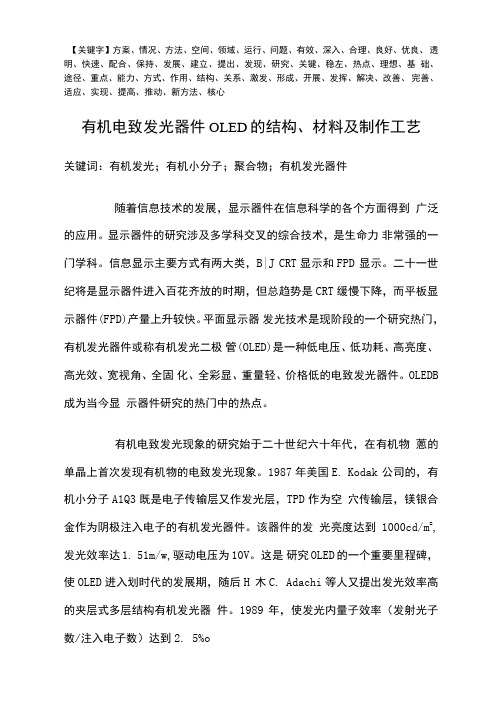
【关键字】方案、情况、方法、空间、领域、运行、问题、有效、深入、合理、良好、优良、透明、快速、配合、保持、发展、建立、提出、发现、研究、关键、稳左、热点、理想、基础、途径、重点、能力、方式、作用、结构、关系、激发、形成、开展、发挥、解决、改善、完善、适应、实现、提高、推动、新方法、核心有机电致发光器件OLED的结构、材料及制作工艺关键词:有机发光;有机小分子;聚合物;有机发光器件随着信息技术的发展,显示器件在信息科学的各个方面得到广泛的应用。
显示器件的研究涉及多学科交叉的综合技术,是生命力非常强的一门学科。
信息显示主要方式有两大类,B|J CRT显示和FPD 显示。
二十一世纪将是显示器件进入百花齐放的时期,但总趋势是CRT缓慢下降,而平板显示器件(FPD)产量上升较快。
平面显示器发光技术是现阶段的一个研究热门,有机发光器件或称有机发光二极管(OLED)是一种低电压、低功耗、高亮度、高光效、宽视角、全固化、全彩显、重量轻、价格低的电致发光器件。
OLEDB 成为当今显示器件研究的热门中的热点。
有机电致发光现象的研究始于二十世纪六十年代,在有机物蔥的单晶上首次发现有机物的电致发光现象。
1987年美国E. Kodak 公司的,有机小分子A1Q3既是电子传输层又作发光层,TPD作为空穴传输层,镁银合金作为阴极注入电子的有机发光器件。
该器件的发光亮度达到1000cd/m=,发光效率达1. 51m/w,驱动电压为10V。
这是研究OLED的一个重要里程碑,使OLED进入划时代的发展期,随后H 木C. Adachi等人又提出发光效率高的夹层式多层结构有机发光器件。
1989年,使发光内量子效率(发射光子数/注入电子数)达到2. 5%o1977年首次报道了聚合物掺杂具有导电性,从此导电聚合物的研究得到飞速发展。
1990年英国剑桥大学的,用旋涂方法制备出聚合物电致发光器件。
提高了OLED的寿命,从而使OLED的研究向纵深发展,并成为世界的研究热点。
OLED发光机理及结构介绍

OLED发光机理及结构介绍OLED(Organic Light-Emitting Diode,有机发光二极管)是一种新型的显示技术,它采用有机薄膜材料作为发光材料,通过电流通过发光材料来产生光。
OLED技术具有低功耗、高对比度、快速响应、广视角等优点,因此被广泛应用于各种显示设备中,如智能手机、电视机、电子阅读器等。
OLED的发光机理是基于有机发光材料的电致发光原理。
OLED的结构主要由五个层次组成:玻璃基板、透明导电层、有机电致发光层、电子传输层和金属电子流层。
首先是玻璃基板,它是OLED显示器的底部结构,主要用来提供对显示器的支撑和绝缘作用。
玻璃基板上涂覆有透明导电层,该层主要由氧化锡(ITO)或氧化铟锡(ITO)等材料组成,它具有优良的导电性能。
透明导电层的主要作用是提供电压来激活OLED。
有机电致发光层是OLED发光的核心,它由有机发光分子组成。
这些有机发光分子可以根据所加电压的不同产生不同的颜色。
有机电致发光层可分为三个子层:发光层、电子输运层和空穴输运层。
发光层是有机分子的主要位置,也是光的发射处。
电子输运层和空穴输运层则用来输送电子和空穴,以确保光的发射效率。
电子输运层和空穴输运层位于有机电致发光层的两侧。
它们分别用来输送电子和空穴,以确保光的发射效率。
电子输运层和空穴输运层通常采用电子亲和力较高的分子材料和空穴亲和力较高的分子材料构成,以使电子和空穴能够有效地在有机电致发光层中运输。
金属电子流层为OLED提供了一个沿着整个层次组件运行的电流路径。
常见的金属电子流层材料有铝和钙,它们具有良好的导电性能。
总的来说,OLED的发光机理是通过施加电压激活有机薄膜材料产生光。
从结构上看,OLED由玻璃基板、透明导电层、有机电致发光层、电子传输层和金属电子流层五个层次组成。
透明导电层用于提供电压,有机电致发光层用于产生光,电子传输层和空穴传输层用于输送电子和空穴,金属电子流层用于提供电流路径。
oled发光机理

oled发光机理OLED发光机理OLED是一种新型的有机发光二极管,其工作原理是在有机材料中注入电子和空穴,当它们在发光材料中重组时会放出能量,从而产生光。
OLED有许多优势,如可以制成柔性屏幕、较高的色彩饱和度、更佳的对比度等,因此在显示领域有着广泛的应用。
OLED发光机理主要包括注入、传输和复合三个过程。
在注入过程中,OLED的阴阳极会通过外加电压将电子和空穴注入到有机材料中,使其处于激发态。
在传输过程中,激发态的电子和空穴会通过有机材料的能级结构进行传输,最终在发光材料处发生复合反应。
在复合过程中,电子和空穴复合时会放出能量,产生光子。
在OLED中,有机材料是关键的组成部分。
有机材料通常由发光材料、传输材料和注入材料三部分组成。
发光材料是指能够发出光的有机分子,其发光机理主要是激子复合发光和分子激发发光。
传输材料是指能够促进电子和空穴传输的有机分子,其作用是将电子和空穴从注入层传输到发光层。
注入材料是指能够将电子和空穴注入有机材料中的有机分子,其作用是在OLED中形成电子和空穴的流动。
OLED的发光机理还与器件结构密切相关。
OLED的器件结构通常包括玻璃基板、透明导电电极、有机材料、金属电极等部分。
透明导电电极通常使用氧化铟锡(ITO)或氧化铟锌(IZO)等材料,其作用是将电压传递到有机材料中。
有机材料通常是以层状结构的方式堆叠在一起,形成多层结构。
金属电极通常使用铝、钙等材料,其作用是将电子和空穴注入到有机材料中。
OLED发光机理是一种基于有机材料的电致发光原理,其主要过程包括注入、传输和复合三个过程。
OLED发光机理的研究和应用有着广泛的前景,可以用于制作柔性屏幕、平板电视、智能手机等电子产品,也可以用于照明、显示、传感等领域。
oled工作原理
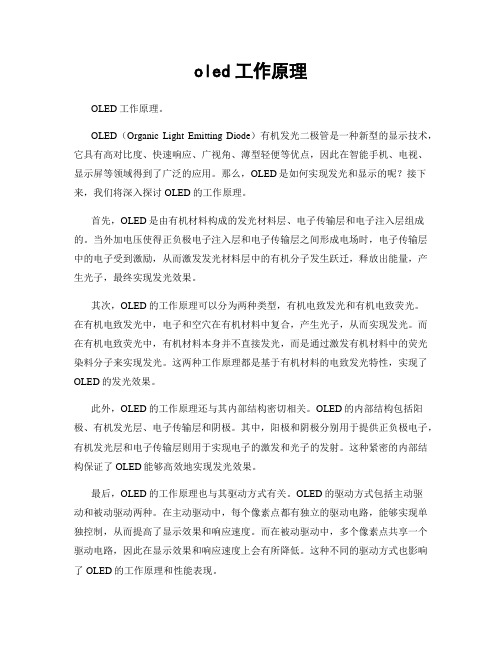
oled工作原理OLED工作原理。
OLED(Organic Light Emitting Diode)有机发光二极管是一种新型的显示技术,它具有高对比度、快速响应、广视角、薄型轻便等优点,因此在智能手机、电视、显示屏等领域得到了广泛的应用。
那么,OLED是如何实现发光和显示的呢?接下来,我们将深入探讨OLED的工作原理。
首先,OLED是由有机材料构成的发光材料层、电子传输层和电子注入层组成的。
当外加电压使得正负极电子注入层和电子传输层之间形成电场时,电子传输层中的电子受到激励,从而激发发光材料层中的有机分子发生跃迁,释放出能量,产生光子,最终实现发光效果。
其次,OLED的工作原理可以分为两种类型,有机电致发光和有机电致荧光。
在有机电致发光中,电子和空穴在有机材料中复合,产生光子,从而实现发光。
而在有机电致荧光中,有机材料本身并不直接发光,而是通过激发有机材料中的荧光染料分子来实现发光。
这两种工作原理都是基于有机材料的电致发光特性,实现了OLED的发光效果。
此外,OLED的工作原理还与其内部结构密切相关。
OLED的内部结构包括阳极、有机发光层、电子传输层和阴极。
其中,阳极和阴极分别用于提供正负极电子,有机发光层和电子传输层则用于实现电子的激发和光子的发射。
这种紧密的内部结构保证了OLED能够高效地实现发光效果。
最后,OLED的工作原理也与其驱动方式有关。
OLED的驱动方式包括主动驱动和被动驱动两种。
在主动驱动中,每个像素点都有独立的驱动电路,能够实现单独控制,从而提高了显示效果和响应速度。
而在被动驱动中,多个像素点共享一个驱动电路,因此在显示效果和响应速度上会有所降低。
这种不同的驱动方式也影响了OLED的工作原理和性能表现。
综上所述,OLED作为一种新型的显示技术,其工作原理涉及到有机材料的电致发光特性、内部结构和驱动方式等多个方面。
通过深入了解OLED的工作原理,我们可以更好地理解其在显示领域的应用和发展,为未来的显示技术提供更多的可能性。
OLED基本原理

OLED基本原理有机发光二极管(Organic Light Emitting Diode,OLED)是一种将有机化合物作为发光材料的薄膜发光二极管。
它是一种电致发光材料,当给其施加正向电压时,有机分子会在发光层中产生电子和空穴的再复合过程,从而释放光能。
由于OLED具有自发光特性,无需背光,因此可以实现更高的亮度和更广的色域。
OLED的基本结构包括玻璃基板、阴极、有机发光层和阳极。
基板是OLED的基础,通常由玻璃或塑料材料制成,其主要作用是提供机械支撑和保护,同时也需要具备透明性,以便光线透过。
阴极是OLED中的电子注入层,通常使用低功函数的材料,如铝镁合金。
它的主要作用是向OLED的有机发光层中注入电子,促使有机分子开始发光。
有机发光层是OLED的核心部分,它是由有机发光材料构成的薄膜,可以通过有机合成方法得到不同颜色的发光材料。
通常,有机发光层被分为不同的层次,包括单层结构、共发光层结构和双发光层结构。
有机发光层中的发光材料通过掺入不同的基团和调整其分子结构,可以实现不同的发光颜色。
当外加电压施加在OLED上时,阴极注入的电子和阳极注入的空穴会在有机发光层中相遇并发生复合反应,产生光子并释放能量,从而实现光的发射。
阳极是OLED中的输运层,它通常采用透明导电材料(如氧化锡镍或氧化铟锡)制成,它的主要作用是为阴极注入的电子提供一种易于输运到有机发光层的路径,同时也需要具备透明性,以便发出的光线透过。
基于上述结构,OLED的工作原理可以总结如下:当外加正向电压施加在OLED的阳极和阴极上时,阴极注入的电子和阳极注入的空穴会在有机发光层中相遇并发生再结合。
在此过程中,由于电子和空穴再结合的能量释放形成的光子被透明导电层和基板透过,最终形成了可见光。
利用不同的有机发光材料以及调整电压和电流的大小,可以实现不同颜色的发光,从而实现彩色显示。
与传统液晶显示技术相比,OLED具有诸多优势,包括响应速度快、可观看角度广、对比度高、色彩饱和度好、自发光无需背光、节能等。
OLED发光机理及结构介绍
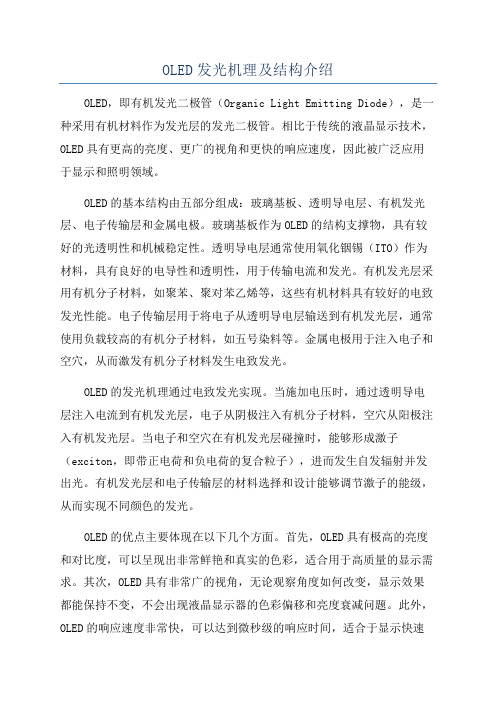
OLED发光机理及结构介绍OLED,即有机发光二极管(Organic Light Emitting Diode),是一种采用有机材料作为发光层的发光二极管。
相比于传统的液晶显示技术,OLED具有更高的亮度、更广的视角和更快的响应速度,因此被广泛应用于显示和照明领域。
OLED的基本结构由五部分组成:玻璃基板、透明导电层、有机发光层、电子传输层和金属电极。
玻璃基板作为OLED的结构支撑物,具有较好的光透明性和机械稳定性。
透明导电层通常使用氧化铟锡(ITO)作为材料,具有良好的电导性和透明性,用于传输电流和发光。
有机发光层采用有机分子材料,如聚苯、聚对苯乙烯等,这些有机材料具有较好的电致发光性能。
电子传输层用于将电子从透明导电层输送到有机发光层,通常使用负载较高的有机分子材料,如五号染料等。
金属电极用于注入电子和空穴,从而激发有机分子材料发生电致发光。
OLED的发光机理通过电致发光实现。
当施加电压时,通过透明导电层注入电流到有机发光层,电子从阴极注入有机分子材料,空穴从阳极注入有机发光层。
当电子和空穴在有机发光层碰撞时,能够形成激子(exciton,即带正电荷和负电荷的复合粒子),进而发生自发辐射并发出光。
有机发光层和电子传输层的材料选择和设计能够调节激子的能级,从而实现不同颜色的发光。
OLED的优点主要体现在以下几个方面。
首先,OLED具有极高的亮度和对比度,可以呈现出非常鲜艳和真实的色彩,适合用于高质量的显示需求。
其次,OLED具有非常广的视角,无论观察角度如何改变,显示效果都能保持不变,不会出现液晶显示器的色彩偏移和亮度衰减问题。
此外,OLED的响应速度非常快,可以达到微秒级的响应时间,适合于显示快速动态画面,例如用于电子游戏和电影播放。
此外,OLED还具有灵活性和可弯曲性,可以制作成柔性显示器,能够应用于曲面显示器、可穿戴设备等领域。
然而,OLED也存在一些问题和挑战。
首先是材料寿命的问题,OLED 的有机材料容易受到氧化、水分和紫外光的影响,会导致发光材料衰减和发光效率降低。
- 1、下载文档前请自行甄别文档内容的完整性,平台不提供额外的编辑、内容补充、找答案等附加服务。
- 2、"仅部分预览"的文档,不可在线预览部分如存在完整性等问题,可反馈申请退款(可完整预览的文档不适用该条件!)。
- 3、如文档侵犯您的权益,请联系客服反馈,我们会尽快为您处理(人工客服工作时间:9:00-18:30)。
摘要OLED 具有全固态、主动发光、高对比度、超薄、低功耗、无视角限制、响应速度快、低电压直流驱动、工作温度范围宽、易于实现柔性显示和3D 显示等诸多优点,将成为未来20 年最具“钱景”的新型显示技术。
同时,由于OLED 具有可大面积成膜、功耗低以及其它优良特性,因此还是一种理想的平面光源,在未来的节能环保型照明领域也具有广泛的应用前景。
本文将系统介绍OLED的发展背景、发展史、制备及应用,介绍了有机电致发光器件(OLED) 的结构和发光机理。
典型的传统OLED是生长在透明的阳极例如ITO玻璃上的,发射出来的光是由最底层衬底透出,这使得它与其他电子元件如硅基显示驱动器的集成变得非常复杂。
因此,理想的做法是研发一种OLED,其光的发射由器件顶部的透明电极透出。
重点介绍一种具有阴极作为底层接触层,阳极ITO薄膜作为顶部电极的表面发射型或者说有机“反转”的LED(OILED)。
介绍了该器件的制备工艺,对该OILED的I 一V特性及EL谱进行了测试,发现与传统的OLED相类似,而工作电压有所升高,效率一定程度上降低。
为了进一步改善器件性能,我们对器件增加了保护层(PL),研究了PL对OILED器件性能的影响。
最后概述了器件的技术进展和应用前景, 并展望了未来OLED 发展的方向。
关键词:有机电致发光器件,有机反转电致发光器件,发光机理,保护层(PL),阳极ITO 薄膜AbstractOLED has a solid state, self-luminous, high contrast, ultra-thin, low power consumption, viewing angle, fast response, low-voltage DC drive, the operating temperature range, easy to implement many of the advantages of flexible displays and 3D displays will become the future20 years ofthe most "money scene" of the new display because OLED has a large-area film, low power consumption, and other fine features, so an ideal plane light source, also has broad application prospects in the future of energy saving lighting in the area. In this paper, the systematic introduction of OLED development background, history of the development, preparation and application, the structure of the organic electroluminescent devices (OLED) and the luminescence mechanism.Typical traditional OLED is growth in transparent anode ITO glass, for example, the light is emitted by bottom gives fully substrate, this makes it and other electronic components such as that the integration of the silica based drive become very complex. Therefore, the ideal way is developing a OLED, its light emission from the top of the device gives fully transparent electrodes. Focuses on a cathode as the bottom contact layer, the anode of ITO films as the top electrode surface emission or organic LED of the "reverse" (OILED). Of the device preparation process, the OILED I-V characteristics and EL spectra of the test, found that similar to the conventional OLED, the working voltage was increased efficiency to a certain extent on the lower. To further improve the device performance of the device to increase the protective layer (PL), PL OILED device performance. Finally an overview of the technical progress and prospects of the device, and looked to the future OLED, the direction of development.Keywords:Organic Electroluminescent Devices,Organic reverse electroluminescent devices,Luminescence mechanism,Protective layer (PL), the anode of ITOfilms.目录摘要................................................................ I Abstract........................................................... I I 目录............................................................... I V 1.绪论.. (1)1.1课题背景 (1)1.2 OLED技术的发展概况 (2)1.2.1 全球OLED发展史 (4)1.2.2 中国OLED发展状况 (5)1.2.3 OLED的应用 (6)1.2.3 OLED的制备 (6)2.有机电致发光器件 (8)2.1 引言 (8)2.2 有机电致发光器件 (8)2.3 有机电致发光器件的结构 (9)2.4 OLED发光机理 (10)2.5 我国发展OLED产业存在的问题及发展趋势 (13)2.5.1 存在的问题 (13)2.5.2 发展趋势 (14)2.6 结论及建议 (14)3.有机反转电致发光器件 (16)3.1 引言 (16)3.2 器件制备工艺 (17)3.2.1 基片的清洗及表面处理 (17)3.2.2 阴极的蒸镀 (17)3.2.3 有机层的成膜 (18)3.2.4 阳极的溅射 (18)/ PVK:TPD/PTCDA/ITO结构的有机反转电致发光器件的研究3.3 Si/Al/Alq3 (19)3.3.1 OILED的I一V特性及亮度测试 (19)3.4 保护层(PL)对器件性能的影响 (26)3.4.1 PL厚度对器件j一V特性的影响 (26)的影响 (28)3.4.2 PL对器件的最大驱动电流Im ax的影响 (28)3.4.3 PL对器件外量子效率qe3.4.4 PL对EL发射谱的影响 (29)3.4.5 顶电极(阳极)面积对载流子注入效率的影响 (30)3.4.6 PL层对器件最表面状态的影响 (31)4.OLED与OILED的特性及存在的问题 (32)4.1 与目前占主流地位的CRT及LCD技术相比,OLED与OILED具有以下更多的优点: (32)4.2 与OLED相比OILED的不同 (34)4.3 OLED与OILED 急待解决的问题和未来发展趋势 (34)结论 (37)5.致谢 (38)6.参考文献: (39)1.绪论1.1课题背景信息显示是信息产业的核心技术之一, 而信息显示技术及显示器件多种多样, 到目前为止,有四种发光物理机制完全不同的固态场致发光形式。
它们分别是基于P-N异质结的无机发光二级管(LED);通过碰撞发光材料而激发的无机电致发光(IEL);由相反电极注入载流子随后在发光层复合辐射跃迁的有机电致发光(OLED);电子在固体中加速的固态阴极射线发光(SSCL)。
在过去的数年里,这些场致显示技术己经取得了长足的进步。
但是,LED还不能实现精细化显示;OLED和IEL的发光效率和寿命等方面还没有达到实际应用的要求;固态阴极射线发光才刚刚诞生数十年,各方面的问题还没有得到彻底的解决。
其中, 有机电致发光显示器件由于响应速度快, 适合于全彩色的动态图象显示, 同时驱动电压低, 能与数字图象VLSI 技术兼容, 也便于实现动态图象的显示驱动, 并且聚合物材料可以通过低成本的工艺做成柔性的大面积平板显示, 所以它是实现未来超薄型可卷壁挂式彩色电视的关键技术, 现被公认为是继液晶显示LCD、等离子显示PBD 后的新一代图形图象显示器件。
有机电致发光的研究起步于60 年代, Pope 首次在蒽单晶上实现了电致发光, 但由于当时需要在大于100V 的驱动电压下才能观察到明显的发光现象, 且量子效率也很低, 还由于受各种条件的制约, 未能很好地解决成膜质量差和电荷注入效率低等问题,所以有机电发光的发展一直处于停滞不前的状态。
直到Alq) 作为发光层, 分1987 年, Tang 和VanSlyke 采用8-羟基喹啉铝络合物(3别用IT O 电极和Mg : Ag 电极作为阳极和阴极, 制成了高亮度( > 1 000cd/ m2 ) , 高效率( 1. 5 lm/ W) 的绿光有机电致发光薄膜器件, 其驱动电压降到了10V 以下,从而取得了有机电致薄膜发光器件研究史上划时代的进展。
由于他们的工作, 又引起了人们对有机电致发光研究的再度关注。
1990 年, Bur roug hes 等人用聚对苯乙烯( PPV) 制备的聚合物薄膜电致发光器件得到了量子效率为0. 05% 的蓝绿光输出, 其驱动电压小于14V。
